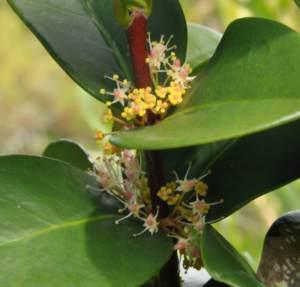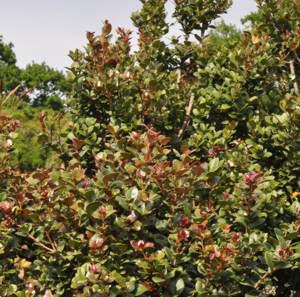Maurocenia frangula
Maurocenia frangula Mill.
Family: Celastraceae
Common names: bittersweet-cherry, Hottentot's cherry, vulture berry, nastergalkersie, hottentotskersie, aasvoelbessie (Afr.)
SA Tree No: 417
Introduction
Maurocenia frangula provides interest throughout the year; with its scarlet, new growth in winter, bright cerise edible berries in autumn, and its decorative, rounded, leathery dark green leaves. It can be used as a small tree or trained as a hedge.

Description
Description
The bittersweet-cherry, is a small rigid tree up to 3 m in height, with a shrubby, rounded shape. The bark is greyish yellow and scaly with vertical fissures. It has a single stem. It is a slow grower, but is long lived.

The dark leathery leaves are widely elliptic to almost circular. The leaves are dark green above and paler below. Each leaf has a prominent midrib which can be seen from either side, but more prominent from below. The margins of the leaves are rolled under. Attaching the leaves to the branches are stout petioles, not more than 3 mm long.
The flowers are very small, ranging from white to dull yellow, and can be found growing in dense branched heads with male and female flowers usually on separate trees, from May to June (late autumn to early spring). The edible berry-like fruits first appear cerise and then turn purple when they ripen. They contain one or two seeds.
Conservation Status
Status
Maurocenia frangula is endemic to the Western Cape, meaning that it is not found growing wild anywhere else in the world. It is common and abundant where it occurs, and its population is stable, which earns it a Red List status of LC (Least Concern).
Distribution and habitat
Distribution description
Maurocenia frangula occurs from the Cape Peninsula to Saldanha Bay in the Western Cape. It is found in coastal bush or forest, mountain ravines, among rocky outcrops and dry slopes. It can be found growing in abundance at the Postberg Nature Reserve near Langebaan. Being a fynbos tree, it grows among a variety of different fynbos species. This tree grows in granite and sandstone soils. In cultivation, plant in well-drained, sandy soils. It is frost- and drought-tolerant when established, and grows in winter rainfall areas.

Derivation of name and historical aspects
History
The genus Maurocenia was named in honour of Gestis Francisci Mauroceni (1658 – 1733), a Venetian patron of science. The specific epithet frangula means ‘tree' with brittle wood. Maurocenia is a monotypic genus in the Celastraceae family. It was incorrectly published as Maurocenia frangularia Willd.
The family consists of about 60 – 70 tree species in southern Africa. It is one of the ten largest tree families in the region. Two exotic species in the family, noteworthy for their attractive, often variegated foliage, are Celastrus and Euonymus. Some noteworthy indigenous ornamental species are found in Cassine, Robsondendron, Maytenus . Catha edulis, known as Bushman's tea or khat, has leaves of which are used medicinally or as a narcotic drug in North Africa and parts of the Middle East.
Ecology
Ecology
The flowers which are present in May and June, are very small, sweet scented and attractive to bees and other insects. The red berries attract seed-eating birds. Birds, therefore, not only eat the berries, but also aid in seed dispersal.

Maurocenia frangula forms part of fynbos, which is a vegetation type that is prone to fires. Most fynbos have adopted a re-seeding or resprouting strategy to survive fires. This species is a resprouter, and is often seen in the field with multiple stems or branches coppicing from the main stem. Some have also adapted to grow in between rocks on high mountains, keeping it safe from fires. In its natural habitat, it is commonly seen with lichen growing on it, which indicates that it is an old plant.
Uses
Use
The wood is yellowish brown and has brown veins. It is fine grained, tough and polishes well. It was once used to make musical instruments. The fruit is edible and was once eaten by Khoisan, hence the common name Hottentot's cherry. This tree should be utilized more in horticulture.
Growing Maurocenia frangula
Grow
Maurocenia frangula is a slow-growing, but tough and wind-tolerant, large shrub or small tree, ideal for fynbos gardens, rockeries and well suited to small gardens. This tree does well in full sun and semi-shade. In gardens use it as an accent plant and it will add interest when the new scarlet leaves are produced.

One can enjoy the edible fruit along with the birds it attracts. It makes a fantastic hedging plant and responds well to pruning, and works well in a mixed hedge. It is also a good container plant, ideal for large pots. The bittersweet-cherry can be planted with succulents such as aloes, vygies, crassulas in rockeries and with plectranthus in a semi-shaded situation. It can also be planted together with restios, proteas, asteraceous plants, and any herbaceous perennials, even other trees. Although this tree is rather rare in horticulture and unfamiliar to many people, it deserves a spot in many more gardens, and should one day become a common garden tree.
Maurocenia frangula can be propagated from seeds and from cuttings. Sow fresh seeds in spring (Sept. – Nov.) or keep them dry and cool, and sow them the following autumn (Mar. – May). Clean the thinly fleshy seeds before sowing. Fill a tray with sandy, well-drained soil such as river sand, cover with a thin layer of the sand and keep moist but not wet. After about 3 weeks germination will take place. They transplant very well. Pot them up into good composted, well-drained soil.
Cuttings must be taken from semi-hard wood in summer (Feb. – Mar.). The leaves must be firm. Take heel or tip cuttings from branches and treat with a rooting hormone. Use a well-drained medium, such as milled bark and polystyrene, and place in a mist unit or in a shaded warm area and water regularly. Rooting will take place between 3 – 6 months. Pot up in spring or whenever roots are abundant.
The plant is not noticeably affected by insect pests, but treat with a good fungicide to prevent fungal disease when sowing seeds or making cuttings.
Acknowledgments
The author would like to thank Ernst van Jaarsveld for propagation information and pictures of Maurocenia frangula in habitat and Alice Notten for help with interpretation and pictures of Maurocenia frangula in flower and fruit.
References
- Archer, R.H. & Victor, J.E. 2005. Maurocenia frangula Mill. National Assessment: Red List of South African Plants version 2014.1. Accessed on 2014/10/29
- Coates Palgrave, M. 2002. Keith Coates Palgrave Trees of southern Africa , edn 3. Struik, Cape Town.
- Goldblatt, P. & Manning, J. 2000. Cape Plants. A conspectus of the Cape flora of South Africa. Strelitzia 9. National Botanical Institute, Pretoria & Missouri Botanical Garden, Missouri.
- Jackson, W.P.U. 1977. Wild flowers of Table Mountain. Howard Timmins, Cape Town.
- Palmer, E. & Pitman, N. 1972. Trees of southern Africa. Balkema, Cape Town.
- Smith, C.A. 1966. Common names of South African plants. Memoirs of the Botanical Survey of South Africa No. 35. Government Printer, Pretoria.
- Van Wyk, A.E. [Braam] & Van Wyk, P. 1997. Field guide to trees of southern Africa . Struik, Cape Town.
- Website: Plants of southern Africa : an online checklist. http://posa.sanbi.org.
Credits
Melissa van der Burg
Kirstenbosch National Botanical Garden
November 2014
Plant Attributes:
Plant Type: Shrub, Tree
SA Distribution: Western Cape
Soil type: Sandy
Flowering season: Late Summer
PH: Acid
Flower colour: Cream, Yellow
Aspect: Full Sun, Afternoon Sun (Semi Shade)
Gardening skill: Average
Special Features:
Horticultural zones








Rate this article
Article well written and informative
Rate this plant
Is this an interesting plant?
Login to add your Comment
Back to topNot registered yet? Click here to register.